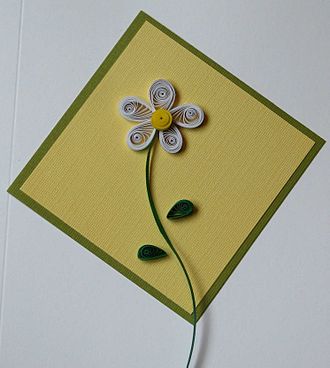Difference between revisions of "AY Honors/Paper Quilling/Answer Key"
m (Reverted edit of 75.141.184.3, changed back to last version by Jomegat) |
|||
| Line 1: | Line 1: | ||
| − | + | [[Image:QuillingShapes.jpg|thumb|Quilling Shapes]] | |
| + | [[Image:Daisy 002.jpg|thumb|Daisy Card]] | ||
| + | '''Quilling''' or '''paper filigree''' is an [[art]] form that involves the use of strips of [[paper]] that are [[roll]]ed, shaped, and glued together to create decorative designs. The paper is wound around a [[quill]] to create a basic [[coil]] shape. The paper is then glued at the tip and the coil shaped, these shaped coils are arranged to form flowers, leaves, and various ornamental patterns similar to ironwork. | ||
| − | + | During the [[Renaissance]], [[France|French]] and [[Italy|Italian]] nuns and monks used quilling to decorate book covers and religious items. The paper most commonly used was strips of paper trimmed from the gilded edges of books. These gilded paper strips were then rolled to create the quilled shapes. Quilling often imitated the original ironwork of the day. The name quilling is said to be derived from the fact that the nuns and monks originally used feather quills as their tool to roll the paper.<ref name="history">{{cite web|url=http://www.mypaperquilling.com/paper_quilling/history_of_quilling.php|title=History Of Quilling|publisher=Paper Quilling Resources|author=|date=|accessdate=2008-03-03}}</ref> | |
| − | |||
| − | Paper | ||
| − | + | In the 18th century, quilling became popular in Europe where "ladies of leisure" practiced the art. Quilling also spread to the Americas and there are a few examples from Colonial times. Many of the pieces that have been preserved from this time are found religious plaques and artwork.<ref name="history"/> | |
| − | |||
| − | |||
| − | |||
| − | |||
| − | |||
| − | |||
| − | |||
| − | |||
| − | |||
| − | |||
| − | |||
| − | |||
| − | |||
| − | |||
| − | |||
| − | |||
| − | + | Today, quilling is seeing resurgence in popularity. The craft has become increasingly popular due to the low cost of the basic material, paper, that is required to make the shapes. It is used to decorate wedding invitations, birth announcements, greeting cards, scrapbook pages, and boxes. Quilling can be found in art galleries in Europe and in the United States and is an art that is practiced around the world.<ref>{{cite web|url=http://www.gemstatequilling.com/history.php|title=The History of Paper Filigree (Paper Quilling)|publisher=Gem State Quilling|author=Paula Bauer|date=2007|accessdate=2008-03-03}}</ref> | |
| − | |||
| − | |||
| − | |||
| − | |||
| − | === | ||
| − | |||
| − | |||
==References== | ==References== | ||
| + | {{Reflist}} | ||
| − | [[Category: | + | ==External links== |
| + | * [http://www.naqg.org North American Quilling Guild (NAQG) - Purpose of the guild is to "promote quilling"] | ||
| + | |||
| + | [[Category:Paper art]] | ||
| + | |||
| + | [[ja:クイリング]] | ||
Revision as of 18:13, 23 April 2008
Quilling or paper filigree is an art form that involves the use of strips of paper that are rolled, shaped, and glued together to create decorative designs. The paper is wound around a quill to create a basic coil shape. The paper is then glued at the tip and the coil shaped, these shaped coils are arranged to form flowers, leaves, and various ornamental patterns similar to ironwork.
During the Renaissance, French and Italian nuns and monks used quilling to decorate book covers and religious items. The paper most commonly used was strips of paper trimmed from the gilded edges of books. These gilded paper strips were then rolled to create the quilled shapes. Quilling often imitated the original ironwork of the day. The name quilling is said to be derived from the fact that the nuns and monks originally used feather quills as their tool to roll the paper.&
In the 18th century, quilling became popular in Europe where "ladies of leisure" practiced the art. Quilling also spread to the Americas and there are a few examples from Colonial times. Many of the pieces that have been preserved from this time are found religious plaques and artwork.&
Today, quilling is seeing resurgence in popularity. The craft has become increasingly popular due to the low cost of the basic material, paper, that is required to make the shapes. It is used to decorate wedding invitations, birth announcements, greeting cards, scrapbook pages, and boxes. Quilling can be found in art galleries in Europe and in the United States and is an art that is practiced around the world.&
References
- ↑ 1.0 1.1 "History Of Quilling". Paper Quilling Resources. http://www.mypaperquilling.com/paper_quilling/history_of_quilling.php. Retrieved 2008-03-03.
- ↑ Paula Bauer (2007). "The History of Paper Filigree (Paper Quilling)". Gem State Quilling. http://www.gemstatequilling.com/history.php. Retrieved 2008-03-03.

